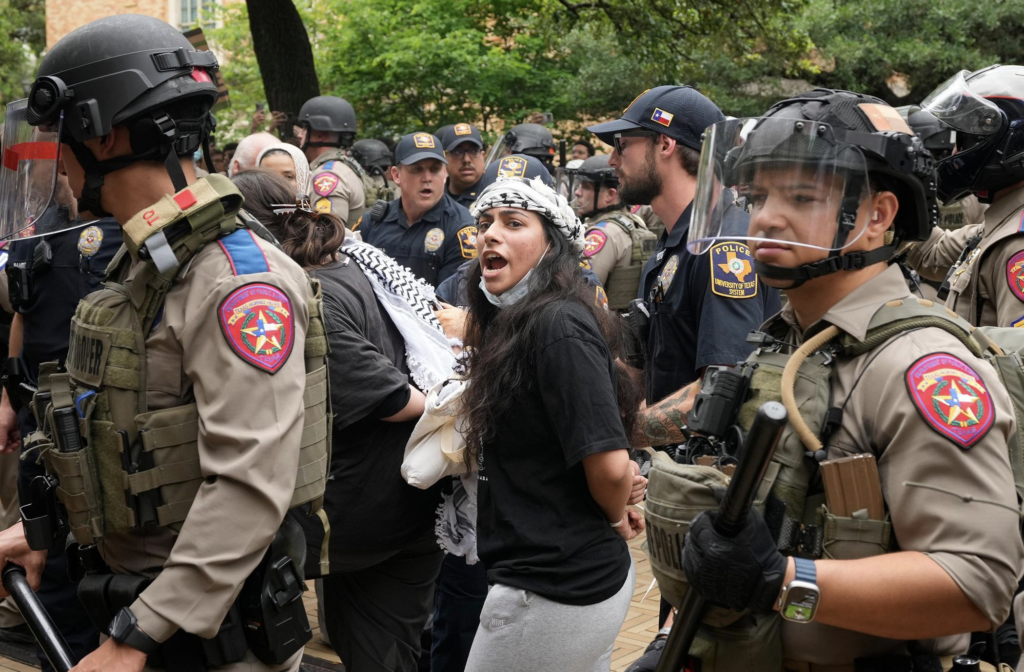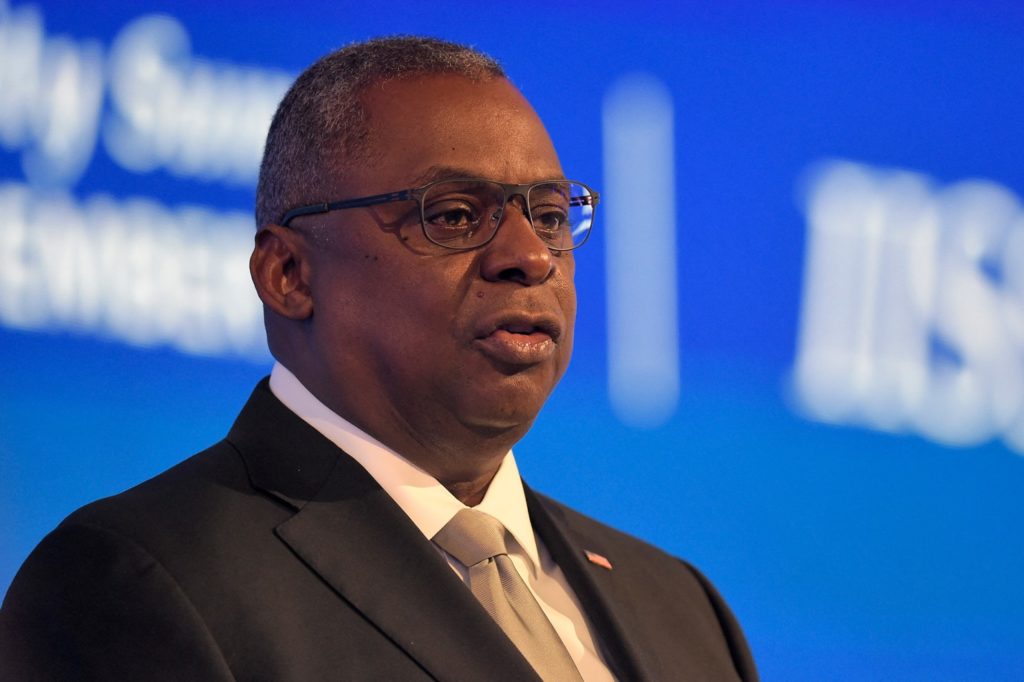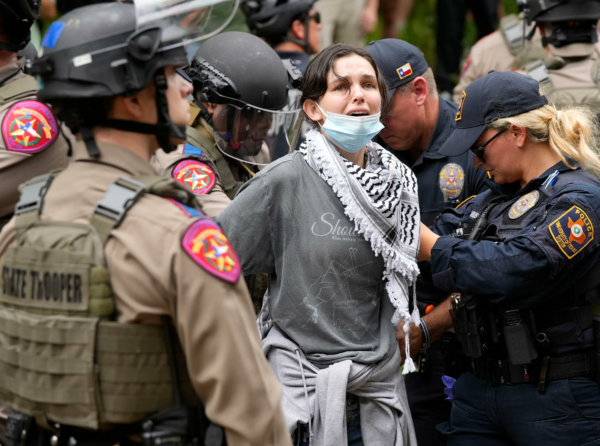A pro-Palestinian protester is being arrested at the Univeristy of Texas in Austin

Authorities break up the pro-Palestinian encampment at UCLA last week. (Jason Armond / Los Angeles Times)
WASHINGTON — The relationship between the United States and Israel has been a tight embrace almost ever since the founding of the Jewish-led state 76 years ago.
Israel has relied on U.S. money, weapons and global diplomatic defense to survive and thrive. Until recently, the support was unflagging from a bipartisan core of Congress and American politicians, and generally from U.S. voters as well.
Formed as a refuge for Holocaust survivors, Israel was often portrayed as a victim and an enduring U.S. ally in a tough and dangerous part of the world.
Israel’s seven-month-old war against the Hamas militant group in the Gaza Strip is testing that relationship.
Reacting to tens of thousands of civilian Palestinian deaths, young Americans are protesting at numerous college campuses across the country. While there have been pro-Israel demonstrations as well, the largest and loudest have been in support of Palestinians.
Here’s a closer look at what the protests might mean for the U.S.-Israel relationship, U.S.-Mideast policy and whether the next generation of Americans will chart a different course.
Why are young people suddenly so interested in this issue?
The Palestinian cause — the quest by millions of Palestinians for independence and a sovereign state after massive displacement by the creation of Israel in 1948 — was wholly marginalized during the Trump administration and remained on the back burner as President Biden pursued the normalization of Israeli ties with its Arab neighbors.

Then came Oct. 7, 2023. Legions of Hamas militants and allies swarmed from Gaza into southern Israel, killing, torching and taking hostages. Around 1,139 Israelis on several kibbutzim and at a music festival were killed; more than 250 were captured and hauled back to Gaza.
Israel’s retaliation was brutal and massive. More than 34,700 Palestinians, mostly women and children, have been killed in Israeli airstrikes and land attacks. Most of Gaza’s population of 2.3 million has been forced to flee their demolished homes.
You can criticize the State of Israel and that’s not antisemitism. So when people stand up and speak against the war in Gaza, when they’re talking about the collective punishment when you deprive people of food as a weapon of war, when- when entire populations displaced when there’s indiscriminate bombing. That is not antisemitism, that is speaking against Israeli policy
Queen rania of Jordan
This new, horrific chapter in the decades-long Israeli-Palestinian conflict brought the issue back to the fore.
Which side do younger Americans support?
Even before Israel invaded Gaza following the Oct. 7 Hamas rampage, polls showed a significant amount of unfavorable viewpoints on Israel among young Americans.
In a 2022 survey by the Pew Research Center, only 41% of adults under 30 had a favorable view of Israel, with 56% unfavorable.
By contrast, the majority of all age groups above 50 viewed Israel favorably.
A Pew poll in February found that among young Democrats, support for Palestinians was overwhelming: 47% favored Palestinians compared to 7% for Israel. Support also declined slightly among older Americans, to just under the majority, but it did not translate into support for Palestinians.
Why the difference among age groups?
In addition to the unpopularity of Israel’s counterattack in Gaza, the generational divide is affected by history and perspective.
“There is a generational replacement,” said Ethan Porter, a professor of media, public affairs and political science at George Washington University in Washington.
Where narratives around Israel and Palestine 30 or so years ago were strong on memories of the Holocaust, today’s activists are more inclined to see Israel not as home to survivors of genocide but as a colonial occupation power perpetuating one.
Nor do younger Americans have first-hand memories of frightening episodes of Palestinian terrorism, such as airplane hijackings in the 1970s and suicide bombs on buses in the late 1990s and early 2000s.
Also, young people — college students in particular — are predisposed to activism on behalf of those seen as oppressed or discriminated against, following the Black Lives Matter and #MeToo movements demanding fairness, justice and civil rights.
Does this mean young U.S. voters care more about the Israeli-Palestinian conflict?
Not necessarily.
Polls suggest the Middle East is not top on the minds of a large number of young Americans.
The Institute of Politics at the Harvard Kennedy School, which has been surveying young voters for more than two decades, found in a poll this year that among 16 topics of importance to voters under 30, the Israel-Gaza war was in next-to-last place.
The top issues in order were inflation, healthcare and housing.
Is Israel losing the PR battle for young Americans?
Maybe.
Israeli governments over the years have invested much effort in what they call their hasbara, or global PR — pushing the Israeli narrative worldwide.
And it was largely successful. This may be the first episode in the long-running Israeli-Palestinian conflict where the Palestinian cause has driven U.S. discourse.
There are many reasons. The sheer scale of Israel’s assault on Gaza, with massive destruction that wiped out entire families, went beyond previous Israeli offensives and quickly overshadowed the Oct. 7 attacks. It is difficult to put positive spin on tens of thousands of dead.

The evolution of social media into an omnipresent visual force has shown the suffering of Gazans to the world relentlessly.
A new generation of Palestinian activists appears far better organized than their predecessors. The Palestinian PR machine was relatively ineffective in the past.
Today Palestinian activists operate busy WhatsApp chats and can flood the zone on par with Israeli hasbara.

A pro-Palestinian protester is being arrested at UCLA
“Social media allows people to see lots and lots of material that affirms what they believe,” Porter said. “The accumulative effect is powerful over time.”
Will the protests change U.S. policy?
That’s the big question.
So far, the college demonstrations, while capturing much attention, show no sign of changing U.S. policy toward the Middle East.

President Biden on Thursday, asked directly if he would alter his approach to Israel in response to the campus chaos, gave a single-word response: “No.”
Several attempts in Congress to condition the billions of dollars in aid the U.S. gives Israel have gone nowhere.
Biden has remained staunchly supportive of Israel’s right to self-defense, but he has also tempered his tolerance of Israeli Prime Minister Benjamin Netanyahu and his right-wing government as they consistently rebuff Washington’s efforts to force Israel to minimize civilian casualties in Gaza and allow the entry of more desperately needed food, water, medicine and other humanitarian aid.

It is Netanyahu’s pugnacious presence at the helm of Israel’s government that has also turned off many American voters, including erstwhile supporters of Israel, polls show.
Biden is also confronting a sharp decline in his political support among Arab American voters, especially in swing states like Michigan, which have a large community of descendants from Lebanon and other Arab nations.
Will these passions among younger Americans last?
It is difficult to say whether these sentiments have staying power.
With college semesters coming to a close for summer, it is possible the protests will taper off.
Students evolve into adults with jobs and often become more conservative or mainstream in their politics, as happened with baby boomers.
Another major Palestinian terrorist attack inside Israel, or violent antisemitic attacks in the U.S., could also restore sympathy for Israel.
On the other hand, young people are vowing to take the pro-Palestinian fight to other venues, including the Democratic National Convention scheduled for August in Chicago and the corporate headquarters seen as complicit in financing the Israeli war effort.
Is this an echo of the anti-Vietnam War protests?
Some comparisons have been drawn between today’s wave of protest to the antiwar movement against U.S. military involvement in Vietnam in the 1960s and ’70s, truly a transformation period in U.S. history that began on university campuses and spread throughout the country.
Some of today’s images to evoke images from a generation ago. Occupying academic buildings. Chanting on green university lawns. Scuffles. And getting arrested by cops.
At Columbia University in New York, the same campus building occupied in 1968, Hamilton Hall, was again broken into and seized by activists in recent days.
But Vietnam had a much more direct effect on many more Americans, infused popular culture and dominated national discourse. Tens of thousands of American men and women were dispatched to the jungles of Southeast Asia and killed in combat. A mandatory draft saw that the pain was distributed among families across the country and across society.
“You can see why people are tempted to draw the analogy,” said Bruce Schulman, a history professor at Boston University who specializes in the Vietnam War and other conflicts. “But the differences are all the more striking.”
Namely, among other elements: the acceleration of both the protest and the response.
It was years into the Vietnam War before the antiwar movement gained momentum; the war in Gaza is about to enter its eighth month. Police units to break up campus demonstrations in the Vietnam era were not called until well into the phenomenon, not in the first days.
Furthermore, Schulman said, the medium-term fallout from the massive antiwar demonstrations in the Vietnam era were not at all what protesters sought. At the national level, the Democratic Party fell apart, politics overall became more conservative, Richard Nixon was elected president in 1968, and the war raged on for several more years with some of the bloodiest, deadliest battles to that date.
LA Times

Leave a Reply
You must be logged in to post a comment.